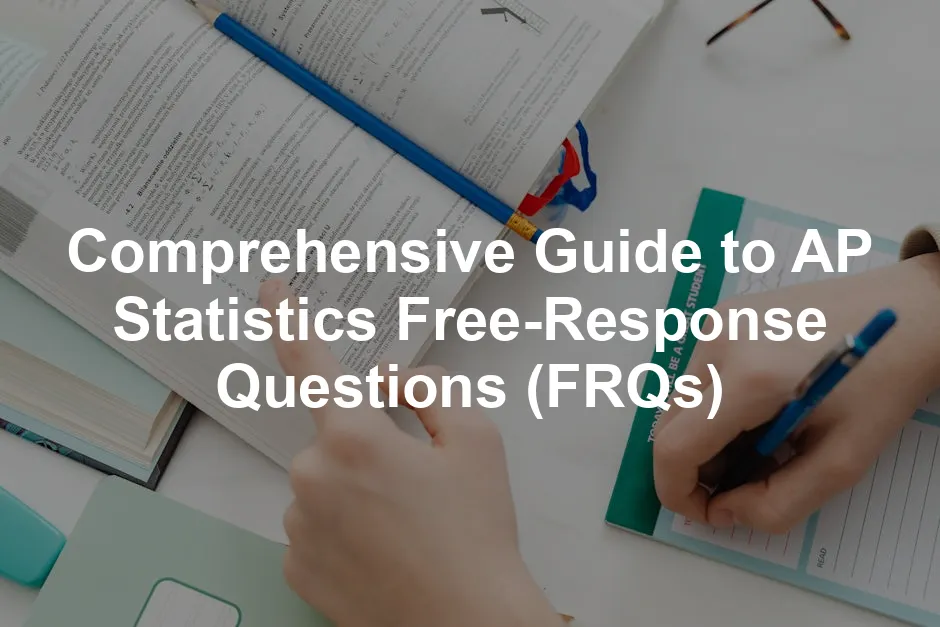Introduction
Have you ever faced the daunting task of tackling free-response questions in AP Statistics? If so, you’re not alone! These questions can feel like a fierce dragon guarding your path to a high score. But fret not! Mastering AP Statistics FRQs is crucial for achieving that coveted 5 on the exam.
These questions test your ability to apply statistical concepts in real-world scenarios. They require not just rote memorization but also a strong grasp of analytical skills. The good news? With the right strategies, you can conquer this section with confidence.
In this guide, we will cover everything you need to know about AP Statistics FRQs. We’ll explore their structure, discuss strategies for success, and provide resources for practice. By the end, you’ll be equipped with the tools to approach these questions like a pro and maybe even find some enjoyment along the way!
Before diving deep, consider picking up an AP Statistics Prep Book. This gem will guide you through the intricacies of AP Statistics and help you build a solid foundation.

Understanding AP Statistics Free-Response Questions (FRQs)
What are FRQs?
Free-response questions, or FRQs, are a vital part of the AP Statistics exam. They challenge students to demonstrate their understanding of statistical concepts through written responses. Unlike multiple-choice questions, FRQs require you to articulate your thought process, show your work, and apply statistical reasoning.
FRQs make up 50% of the total exam score. This substantial weight emphasizes their importance in determining your overall performance. So, think of them as the golden ticket to achieving a high score!

Weight
In the AP Statistics exam, the FRQ section is divided into two parts. Part A consists of five short-answer questions, while Part B includes one investigative task. Together, these questions assess a range of skills, from data collection to statistical inference. It’s crucial to understand that doing well on the FRQs can significantly boost your score. Therefore, dedicating time to practice and master this section is essential for success.
As you prepare, remember that practice makes perfect. Familiarize yourself with the types of questions that appear on past exams. Knowing the format and expectations will help you navigate the FRQ section with ease.
And don’t forget to grab a set of AP Statistics Flashcards to help reinforce those key concepts while on the go!

Structure of the FRQ Section
The AP Statistics exam has a unique structure that students must understand to excel. The Free Response Questions (FRQs) section consists of two main parts.
Part A features five short-answer questions. These questions focus on various skills, such as collecting data, exploring data, and applying statistical methods. Each question can include multiple parts, so be prepared to tackle several related questions at once.
Part B is an investigative task that requires a deeper application of statistical concepts. This task assesses multiple skills and applies them to a real-world scenario. It usually involves a substantial amount of analysis and interpretation.
Now, let’s talk about time management. The FRQ section is allocated a total of 90 minutes. Students should aim to spend approximately 65 minutes on Part A and around 25 minutes on Part B. This division allows for careful consideration of each question while ensuring you have enough time to complete the investigative task.
To manage your time effectively, it’s wise to start with the questions you feel most confident about. This not only boosts your morale but also ensures you secure those points early on. Remember, every minute counts, so keep an eye on the clock!

Scoring Rubric
Understanding the scoring rubric for FRQs is essential for maximizing your exam performance. Each response is evaluated based on a three-tiered system: essentially correct, partially correct, and incorrect.
Essentially Correct responses show a complete understanding of the question. They include all necessary steps and calculations, demonstrating a clear thought process. For example, if a student correctly conducts a hypothesis test and accurately interprets the results, they may fall into this category.
Partially Correct responses indicate some understanding but may have minor errors. For instance, if a student shows the correct setup for a problem but miscalculates a key value, they can still earn partial credit for their approach.
Incorrect responses fail to meet the criteria of the question. They may lack necessary components, show significant errors, or misinterpret the data.
To illustrate, let’s consider a strong response versus a weak one. A robust answer would not only calculate the mean of a dataset but also describe its implications in context. Conversely, a weak response might simply state the mean without further analysis, leading to a lower score.
Understanding this scoring system is crucial. With this knowledge, you can tailor your responses to maximize your points on the AP Statistics FRQs.

Past Exam Trends
Analysis
When it comes to AP Statistics FRQs, certain trends emerge from the past exam data. The frequency of topics often reflects what students need to master. For instance, questions focusing on inference methods, such as confidence intervals and hypothesis tests, appear regularly. These topics dominate the FRQs, suggesting they are vital for student success. Understanding statistical inference is key to tackling these questions effectively.
Additionally, multi-part questions are common. Students often need to show their work through calculations, interpretations, and justifications. This highlights the importance of not just finding the answer but understanding the underlying statistical concepts.

Examples
Specific FRQs from previous years illustrate these trends. For example, the 2021 FRQ included a multipart question on collecting data and determining relationships between variables. This question tested students’ abilities to apply knowledge from multiple units, reinforcing the idea that understanding how to integrate concepts is crucial.
Another example is the 2019 FRQ, which featured an investigative task involving a two-proportion z-test. This task required students to analyze real-world data and make statistical inferences, emphasizing its relevance in the exam.
Looking back at these examples, it’s clear that students should focus their study efforts on inference methods and multi-part questions. By doing so, they can better prepare for the types of FRQs that consistently appear on the exam.
Approaching the Exam
Question Selection
When facing the AP Statistics FRQs, question selection can be your secret weapon! Start with the questions that appear less intimidating. These are often the simpler ones that can boost your confidence and your score. If the investigative task catches your eye, tackle it first. It often requires more thought and time, so getting it out of the way early can ease the pressure.
If you choose to start with the easier questions, it’s a quick way to rack up points! Just remember: each correct answer adds to your overall score, so prioritize your strengths. Think of it as a warm-up before diving into the heavy lifting.

Time Management
Time is of the essence in the FRQ section. You have 90 minutes to complete six questions. Here’s a handy breakdown: allocate around 65 minutes for Part A, which contains five short-answer questions. This gives you roughly 10-12 minutes per question. For Part B, dedicate about 25 minutes to the investigative task.
Keep a watchful eye on the clock! Spend a quick moment glancing through all questions at the beginning. This will help you gauge which ones you can answer quickly and which might need a bit more time. Balancing speed with accuracy is key. You want to answer as many questions as you can while ensuring each response is thorough and well-explained.
Consider utilizing a Timed Study Timer to help you keep track of your time during practice sessions.

Common Pitfalls to Avoid
Mistakes
Oh, the mistakes! They can sneak up on you like a cat in a sunbeam. One common pitfall is failing to read the questions carefully. Often, students rush through and miss key instructions or details. Make sure you understand what each question is asking. Another frequent error is neglecting to show your work. For many questions, partial credit is awarded for the correct methodology, even if the final answer is incorrect.
So, write everything down! If you make a mistake, don’t panic. Just ensure your reasoning is clear and easy to follow.

Understanding Verbs
Understanding the verbs used in the questions is crucial. Words like “calculate,” “describe,” and “explain” have specific meanings in the context of statistics. “Calculate” means to perform the necessary computations, while “describe” requires you to summarize and interpret the results.
Failing to grasp these verbs can lead to a skewed response. For example, if a question asks you to “explain,” avoid just listing facts. Instead, articulate your reasoning and connect it back to the question.
Being aware of what each verb entails can help you craft precise and relevant answers. This attention to detail can make a significant difference in your overall score!

Resources for Practice and Further Study
Online Resources
Official College Board Materials
For those serious about mastering AP Statistics, the College Board website is a goldmine! You can find a treasure trove of past FRQs along with scoring guidelines and sample responses. These resources help you familiarize yourself with the exam format and expectations. Check it out here.

Additional Study Websites
1. Stats Medic
This site provides a comprehensive list of all the FRQs from previous AP Statistics exams, organized by topic. Perfect for focused study sessions! Visit their searchable FRQ bank here.
2. Fiveable
Another fantastic platform that offers study guides, practice questions, and a community of fellow students. It’s a great way to engage with others and deepen your understanding of the material. Check out their resources here.
3. Math Medic
This blog features various AP exam strategies, favorite questions, and important tips for success. Their insights can help you approach the FRQs with more confidence. Explore their content here.

Practice Questions
Practice makes perfect! Look for example FRQs and solutions available across various platforms. This will help you understand the types of questions you might face and how to structure your answers effectively.
While practicing, consider using a Graphing Calculator (TI-84 Plus). It’s an essential tool that will make those calculations a breeze.

Study Guides
Comprehensive guides summarizing statistical concepts specifically for the FRQs can be invaluable. They’ll serve as a quick reference to reinforce your understanding before the exam.
With these resources, you’ll be well-equipped to tackle the AP Statistics FRQs effectively. Happy studying!

Conclusion
In this guide, we’ve navigated the intricate landscape of AP Statistics Free-Response Questions (FRQs). We uncovered their definition, importance, and how they shape your final score. Remember, these questions account for a whopping 50% of your AP exam score. So, it’s vital to understand them and practice diligently.
Preparation is key! Engaging with past FRQs, understanding the scoring rubric, and using effective study strategies can elevate your performance. The resources provided will be your trusty sidekicks in this adventure, so don’t hesitate to explore them.
As you embark on this journey to mastering FRQs, keep in mind that practice is your best ally. The more you work on these questions, the more comfortable you’ll become. And remember, every expert was once a beginner. Your determination and effort will pay off!
With the right mindset and resources, you can conquer the FRQ section and achieve that desired score. So, roll up your sleeves, grab those study materials, and start practicing! Engage with your peers, discuss tricky problems, and share insights. You’ve got this!
FAQs
What is the format of the AP Statistics exam?
The exam consists of two sections: Multiple Choice and Free Response. The multiple-choice section includes 40 questions, while the FRQ section contains six questions—five short-answer and one investigative task. Both sections weigh equally at 50% of the total score.
How can I best prepare for FRQs?
To excel in FRQs, practice regularly with past exam questions. Focus on understanding the concepts behind the questions and their applications. Collaborating with study groups can also enhance your learning experience.
How are FRQs scored?
FRQs are scored using a rubric that categorizes answers as essentially correct, partially correct, or incorrect. Each response is evaluated based on its completeness, accuracy, and clarity. Understanding this rubric can help you tailor your answers for maximum points.
Where can I find past FRQs to practice?
The College Board’s official website provides a comprehensive repository of past FRQs and scoring guidelines. Additionally, websites like Stats Medic and Fiveable offer searchable databases of released questions.
What are the most common topics covered in FRQs?
Common topics in FRQs include inference methods, sampling distributions, and data analysis. Familiarizing yourself with these units will give you an advantage in tackling these questions effectively.
Please let us know what you think about our content by leaving a comment down below!
Thank you for reading till here 🙂
All images from Pexels




